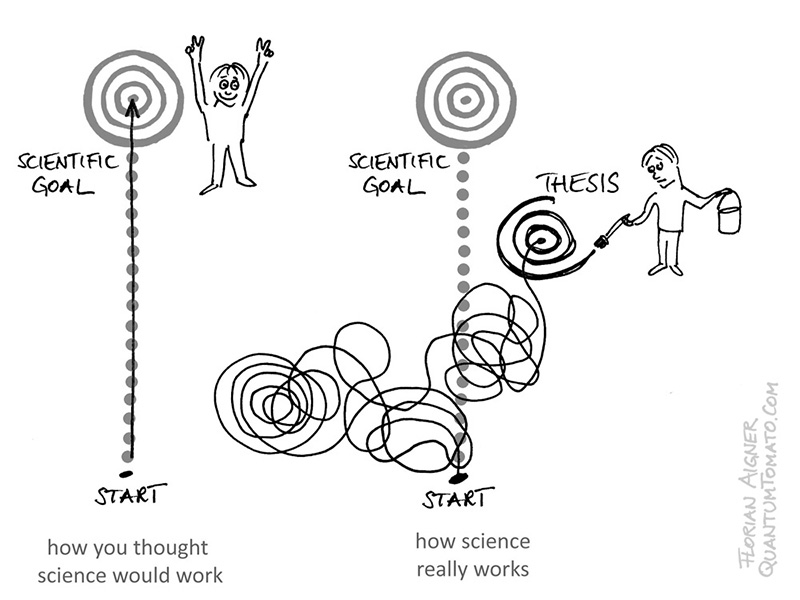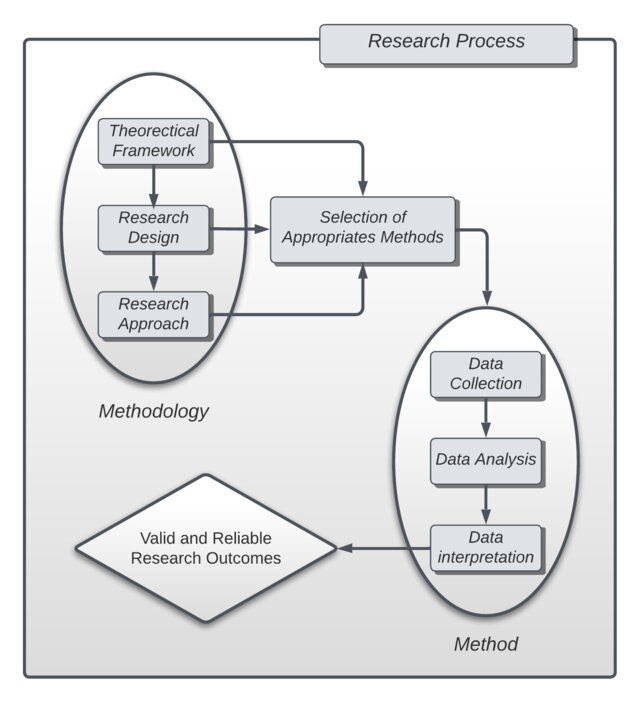Research Design
This section will guide you through the process of designing your research project. An adequate research design is crucial for the success of your thesis, and can save you a lot of time and effort later on.
A well-defined research design will lead you to a clear research question, a solid methodology, and a coherent structure for your thesis. Conversely, a poorly defined research design can lead to confusion, wasted time, and a lack of focus, wearing you down and making it difficult to complete your thesis. You may take longer then expected to reach your scientific goal, or even worse, you may not reach it at all (see, e.g., Figure 1).
Some research is inevitably exploratory, but you can make the most to control what you can control and take the necessary steps to ensure that your research design is as solid as possible.

Context Analysis: Chopping the Tree vs Sharpening the Ax
Abraham Lincoln was quoted as saying
“Give me six hours to chop down a tree and I will spend the first four sharpening the ax.”
What does this have to do with thesis writing?
Just like sharpening the ax represents preparatory work for Lincoln, in problem-solving, this translates to properly understanding and framing the problem before jumping to solutions. In the context of thesis writing, understanding and framing are the Introduction, Context Analysis, and Literature Research sections.
I understand it’s tempting to dive straight into “chopping the tree,” especially in a company context where you are pressured to show results. Although rushing to action without proper preparation might yield quick results, these may not be the most effective, sustainable, or even useful for the company.
The following steps might be helpful in dealing with the sharp vs. chop dilemma:
- Framing the Problem: This is the “sharpening” stage. It involves defining the problem, understanding its context, and identifying the key factors involved. This stage is crucial because a well-defined problem often suggests its own solutions. It’s about gathering relevant information, asking the right questions, and setting clear objectives. Skipping or rushing through this stage can lead to misdirected efforts or solving the wrong problem.
- Developing a Strategy: Once the problem is clearly framed, the next step is strategizing how to approach it. This includes brainstorming potential solutions, evaluating their feasibility, and deciding on the best course of action. This is analogous to planning the best way to use the ax after it has been sharpened.
- Implementation: After the preparation and planning stages, it’s time to “chop the tree” or implement the chosen solution. The thoroughness of the first two stages makes this part more effective and efficient. The better the understanding and planning, the smoother the execution tends to be.
Scope and Limitations
Scope and limitations are two important aspects that are considered in any research or project. The main difference between them is as follows:
Scope refers to the boundaries of the research or project. It defines the extent and coverage of the study. It outlines what will be included and excluded from the research or project. The scope defines the parameters of the study and helps to keep the research or project focused.
Limitations, on the other hand, refer to the shortcomings or weaknesses of the research or project. They are the factors that could affect the accuracy, reliability, and validity of the research or project. Limitations are the aspects that the researcher or project team cannot control or overcome. They are the factors that could limit the generalizability or applicability of the study findings.
In summary, scope defines the boundaries and extent of the research or project, while limitations refer to the factors that could affect the accuracy and generalizability of the study findings.
Method vs. Methodology
In academic and practical research, the terms method and methodology are often used interchangeably, creating confusion among researchers and practitioners. This misunderstanding can lead to flaws in research design and implementation, ultimately affecting outcomes.
A method refers to the specific techniques or procedures, whereas a methodology encompasses the broader research design, including the theoretical framework, research questions, and guiding principles for selecting appropriate methods (Aguiar 2024). While the method focuses on the practical steps of research, the methodology determines the overall approach and rationale.
For example, in a study aiming to improve service levels in a mobility service, the method might involve implementing a reinforcement learning algorithm to optimize vehicle routing based on historical data. Meanwhile, the research methodology would encompass the study’s overall approach, which includes the rationale for selecting reinforcement learning as the most appropriate means to address the research question among other possible methods.
Figure 2 shows how the method and methodology are distinct yet interconnected components of research design.

A rigorous methodology ensures that research aligns with established principles and theories, enhancing the validity and reliability of findings. This way, the methodological framework guides the selection of appropriate methods, ensuring that research outcomes are verifiable and replicable. On the other hand, a well-chosen method provides the practical means to achieve research objectives within the established methodological framework.